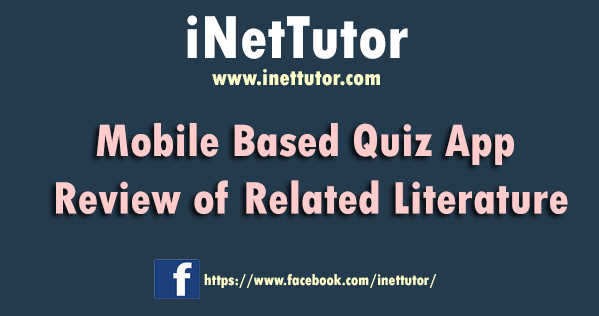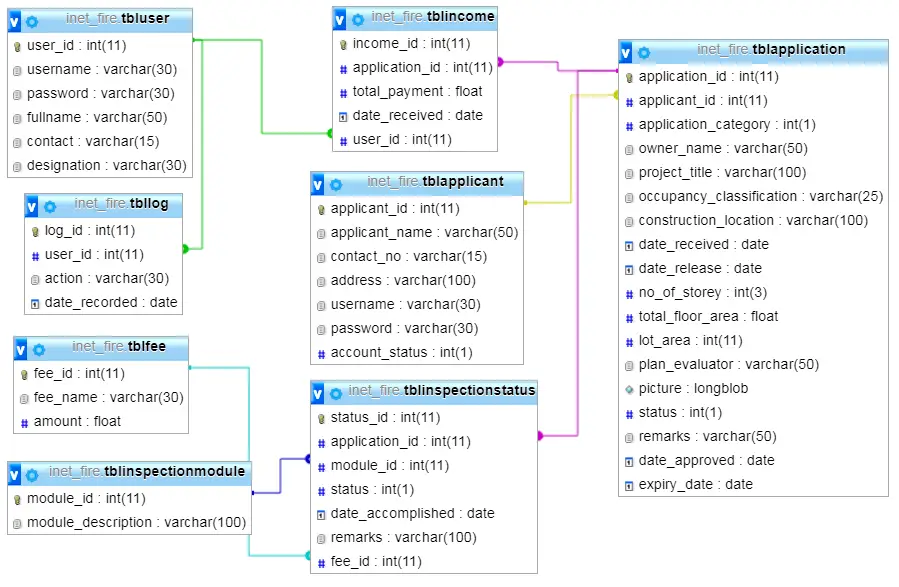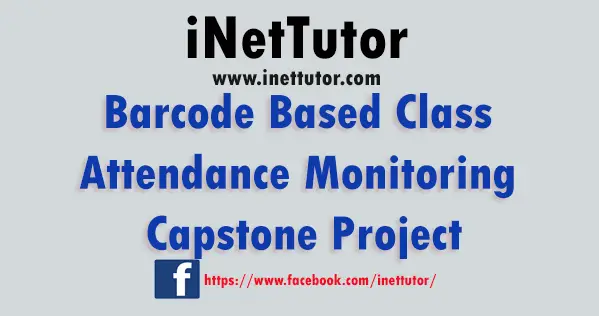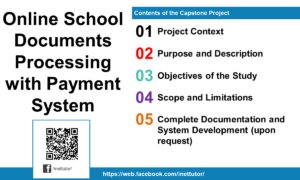Mobile Based Quiz App Review of Related Literature
The project entitled mobile based quiz app is an alternative method for pen and paper type of test, the mobile application quiz app was designed in a hybrid type of mobile development which means that the project can be installed on both iOS and Android devices. JQuery Mobile and Apache Cordova were used as the development tools, JQM is composed of HTML, CSS and Javascript files and the Apache Cordova is responsible for compiling the project into a mobile application. This article will provide you with the studies and systems which are closely related to this project.

Foreign
The prevalence of mobile technologies is in itself a motivator to exploit them for learning. Mobile technologies are already widespread among children (NOP 2001). It makes sense, then, for an educational system with limited information and communication technology (ICT) resources to make the most of what children bring to the classroom.
(Hennessy 1999).Mobile technologies provide an opportunity for a fundamental change in education away from occasional use of a computer in a lab towards more embedded use in the classroom and beyond.
Sharples (2003) suggests that rather than seeing them as disruptive devices, educators should seek to exploit the potential of the technologies children bring with them and find ways to put them into good use for the benefit of learning practice.
Soloway et al (2001) have further argued that to make any difference in the classroom at all, computers must be mobile and within ‘arm’s reach’. The nature of learning is closely linked to the concept of mobility.
Vavoula and Sharples (2002) suggest that there are three ways in which learning can be considered mobile: “learning is mobile in terms of space, ie it happens at the workplace, at home, and at places of leisure; it is mobile between different areas of life, ie it may relate to work demands, self-improvement, or leisure; and it is mobile with respect to time, ie it happens at different times during the day, on working days or on weekends”.
The supposed value of mobiles also arises from the manner in which they facilitate lifelong learning. Mobiles can support the great amount of learning that occurs during the many activities of everyday life, learning that occurs spontaneously in impromptu settings outside of the classroom and outside of the usual environment of home and office. They enable learning that occurs across time and place as learners apply what they learn in one environment to developments in another (Sharples et al.)
(Sharples et al., 2007.) Mobile phones theoretically make learner-centered learning possible by enabling students to customize the transfer of and access to information in order to build on their skills and knowledge and to meet their own educational goals.
(Nyiri, 2002; Sharples et al., 2007) Given that social interaction is central to effective learning, as indicated by theories of new learning, mobile phones should also impact educational outcomes by facilitating communication. Mobiles permit collaborative learning and continued conversation despite physical location and thus advance the process of coming to know, which occurs through conversations across contexts and among various people. Via mobile technology, learners engage in conversation whereby they resolve differences, understand the experiences of others, and create common interpretations and shared understanding of the world.
(Geddes, 2004) In promoting educational modalities that accord with the theories of new learning, mLearning should offer an appeal aspect that also impacts educational outcomes. MLearning can be particularly appealing for those who have not succeeded in traditional learning environments; it can attract those not enamored by traditional learning approaches that are generalized and decontextualized in nature. Meaning is also beneficial in that it can provide immediate feedback and thus provide continued motivation for those who are not motivated by traditional educational settings. Moreover, mLearning presents an appeal simply because the use of mobile technology in and of itself presents something new and exciting for a great array of learner.
http://www.irrodl.org/index.php/irrodl/article/view/794/1487
O’Neil, Wainess, & Baker, 2005) Games can also be adapted based on students’ needs. Appropriate scaffolding can be provided in games through the use of levels. Supports are embedded into games such that easier levels are typically played first, advancing on to more complex levels as the player achieves mastery. For example, scaffolding is built into the science mystery game Crystal Island by allowing students to keep records of the information they have gathered and the hypotheses they have drawn (Ash, 2011). Other scaffolding can be achieved through the use of graphics, such as navigation maps, which can lower a player’s cognitive load while playing the game.
http://researchnetwork.pearson.com/wpcontent/uploads/Lit_Review_of_Gaming_in_Education.pdf
(Black & Wiliam, 1998). Games also are built with clear goals and provide immediate feedback (Dickey, 2005). This allows players to change their game play in order to improve their performance and reach their goals. The idea of immediate feedback is also prominent in good formative assessment processes. Students will improve their work when given constructive feedback.
http://researchnetwork.pearson.com/wpcontent/uploads/Lit_Review_of_Gaming_in_Education.pdf
(Gee 2003. Spires 2008) GAMES frequently cited as an important mechanisms in teaching because they can accommodate a wide variety of learning style within a complex decision making context (Squirre 2006). The skills and context of many games take advantage of technology that is familiar to students and use relevant situation.
http://researchnetwork.pearson.com/wpcontent/uploads/Lit_Review_of_Gaming_in_Education.pdf
(Cf. Klopfer et al., 2011) Game design needs to adapt to different target groups, contexts, etc. (Adams, 2010). This in particular applies to the context of educational games. There is a vital need for tailoring learning offers (i.e. educational games) to learners’ needs, capabilities and according to learning targets. Intelligent adaptive game mechanisms generally reflect this need. To a certain degree, this also applies to the patterns Level or Score. This way, the pattern approach reflects varying target groups or contexts. A more specific analysis, e.g. the extent to which individual patterns reflect learners’ needs or capabilities, is needed. Though future research needs to verify the effectiveness of mobile learning games and to corroborate their educational value in order to motivate students to use such tools for teaching. Otherwise, the educational system may run the risk of disengaging future learners.
(Wang et al., 2008) There are a number of mobile game-based learning projects that have already tested and evaluated the effects of mobile games on students’ learning. Only few trace their findings back to individual game mechanisms or patterns in order to better understand why a game is successful. Instead, reports often reason effects with the use of the game itself, e.g. “students found the use of Lecture Quiz engaging, they perceived they learn more using such games.
Mobile technologies offer learning experiences which can effectively engage and educate contemporary learners and which are often markedly different from those afforded by conventional desktop computers. These devices are used dynamically, in many different settings, giving access to a broad range of uses and situated learning activities. The personal nature of these technologies means that they are well suited to engaging learners in individualized learning experiences, and to giving them increased ownership (and hence responsibility) over their own work. Most previous reviews of mobile technologies for learning categorize examples of use according to curriculum area. We believe that the benefits of mobile technologies for learning encompass more than just what an individual can do with a device, and that there is thus a need for a wider review of new and emerging practices and how these relate to theories and paradigms previously established for the use of computers in education.
http://www2.futurelab.org.uk/resources/documents/lit_reviews/Mobile_Review.pdf
(Goodyear 2000) The close relation of learning to the context and the situation in which the learning need arises has been widely discussed in the literature (Brown et al1989; Lave and Wenger 1991) and the benefits of just-in-time, situated learning have been explored. Nyiri(2002) notes that knowledge is information in context and since mobile devices enable the delivery of context-specific information they are well placed to enable learning and the construction of knowledge.
http://www2.futurelab.org.uk/resources/documents/lit_reviews/Mobile_Review.pdf
(Lederman & Fumitoshi, 1995) However, learning does not just end with the game. Debriefing is critical to using games in education as it provides the connection between learning in the game and applying those skills to other contexts. Teachers can facilitate the transfer of skills by leading pre- and post-game discussions which connect the game with other things students are learning in class (Ash, 2011). Ke (2009) concluded that instructional support features are necessary in order for the lessons learned in computer games to transfer to other contexts. Video games can be used to create deeper learning experiences for students, but they do not provide the entire experience. Steinkuehler & Chmiel (2006) suggest that games will not replace teachers and classrooms, but they might replace some textbooks and laboratories.
http://researchnetwork.pearson.com/wpcontent/uploads/Lit_Review_of_Gaming_in_Education.pdf
Local
The concept of mobile learning (mLearning) – understood for the purposes of this article as learning facilitated by mobile devices – is gaining traction in the developing world. The number of projects exploring the potential of mobile phone-facilitated mLearning in the developing world is steadily growing, spurred in part by the use of mobile technology in the educational sector in the developed world which has expanded from short-term trials on a small scale to large-scale integration. However, there remains a lack of analysis that brings together the findings of the rising number of mLearning projects in the developing world.
With the increasing attention now being given to the role of mobiles in the educational sector in developing countries, there is a need at this juncture to take stock of the available evidence of the educational benefits that mobile phones provide in the developing world. Consequently, this article explores the results of six mLearning projects that took place in several developing countries in Asia – the Philippines, Mongolia, Thailand, India, and Bangladesh – both because most developing-country mLearning interventions are being undertaken in Asia and because developments in Asia seem to indicate that the region could become the global leader in educational uses of mobiles (Motlik, 2008). In exploring how mobile phone-facilitated mLearning contributes to improved educational outcomes, this article examines two specific issues: 1) the role of mobiles in improving access to education, and 2) the role of mobiles in promoting new learning, those new learning processes and new instructional methods currently stressed in educational theory. Of note, the projects reviewed deal with both formal and non-formal education as defined by Dighe, Hakeem, and Shaeffer (2009, p. 60).
http://www.irrodl.org/index.php/irrodl/article/view/794/1487
Review of Related Study
Despite improvements in educational indicators, such as enrolment, significant challenges remain with regard to the delivery of quality education in developing countries, particularly in rural and remote regions. In the attempt to find viable solutions to these challenges, much hope has been placed in new information and communication technologies (ICTs), mobile phones being one example. This article reviews the evidence of the role of mobile phone-facilitated mLearning in contributing to improved educational outcomes in the developing countries of Asia by exploring the results of six mLearning pilot projects that took place in the Philippines, Mongolia, Thailand, India, and Bangladesh. In particular, this article examines the extent to which the use of mobile phones helped to improve educational outcomes in two specific ways: 1) in improving access to education, and 2) in promoting new learning. Analysis of the projects indicates that while there is important evidence of mobile phones facilitating increased access, much less evidence exists as to how mobiles promote new learning
Skills Arena (Lee et al 2004) is a mathematics video game, implemented using the Nintendo Game Boy Advance system that supplements traditional curricular and teaching methods.
(Lonsdale et al 2003; 2004) MOBIlearn, a major European research project, is focusing on the context-aware delivery of content and services to learners with mobile devices.
http://www.irrodl.org/index.php/irrodl/article/view/794/1487
(Keegan, 2002) In so much as mLearning exerts an impact on educational outcomes by increasing access, mLearning represents a continuation and improvement of distance learning through increased utility and applicability MLearning, the literature suggests, broadens the availability of quality education materials through decreased cost and increased flexibility while also enhancing the efficiency and effectiveness of education administration and policy.
http://www.irrodl.org/index.php/irrodl/article/view/794/1487
Credits to the authors and developers of the project
You may visit our Facebook page for more information, inquiries, and comments. Please subscribe also to our YouTube Channel to receive free capstone projects resources and computer programming tutorials.
Hire our team to do the project.


